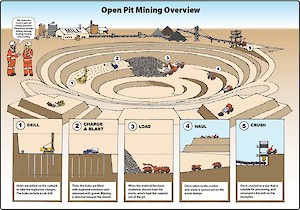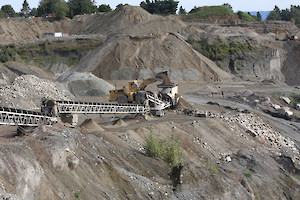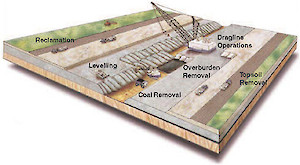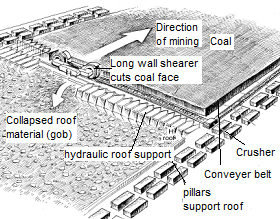Mining Methods
There are many different ways to mine mineral resources from the Earth. The method that is used depends where the mineral resource is located, at the surface or underground, its size and shape, and if it is very hard or relatively soft.
Surface Mining Methods
Surface mining methods are used when a mineral resource is at or near the Earth's surface. There are several types of surface mining including open pit, strip mining, quarrying, placer mining, and evaporation ponds. In British Columbia today, open pit mining and quarrying are common, while placer mining for gold was common in the early days.
Open Pit Mining
 The open pit method is used for large mineral resource deposits that are at or near the Earth's surface. It is commonly used for base metal deposits that are very large. Such deposits can be efficiently and profitably mined using very large equipment even if the deposit is low-grade. As mining proceeds from the surface downward, this type of mine forms a pit with stairstep-like walls made by the mined benches.
The open pit method is used for large mineral resource deposits that are at or near the Earth's surface. It is commonly used for base metal deposits that are very large. Such deposits can be efficiently and profitably mined using very large equipment even if the deposit is low-grade. As mining proceeds from the surface downward, this type of mine forms a pit with stairstep-like walls made by the mined benches. Quarrying
Quarrying generally refers to surface mining that does not require complex processing. Quarrying is used to mine sand and gravel, crushed stone aggregate, many industrial minerals (like limetone, gypsum and magnesite), and dimension stone for building material and construction.
 Sand and gravel quarries extract sediment that is not cemented together into solid rock. Blasting is not required. Instead, the loose material is scooped up with a front end loader or scraped from the quarry floor with a scraper, and then hauled to a mechanical processing plant where the sediment is sorted by size.
Sand and gravel quarries extract sediment that is not cemented together into solid rock. Blasting is not required. Instead, the loose material is scooped up with a front end loader or scraped from the quarry floor with a scraper, and then hauled to a mechanical processing plant where the sediment is sorted by size. Crushed stone aggregate and industrial mineral quarries are similar to open pit mines in that they are developed in hard rock that requires blasting to begin mining. After blasting, the broken material is hauled by a loader or loaded into a truck and taken to a crusher. Crushed stone aggregate is conveyed to a mechanical processing plant at the quarry, that sorts the crushed stone by size for different construction uses. Crushed industrial minerals that require finer grinding and additional processing, like making wallboard from gypsum or kitty litter from clay, will be conveyed or hauled by truck out of the quarry to a plant where those steps occur.
Dimension stone quarries use techniques that make it possible for very large blocks of rock to be wedged loose or sawed out of a deposit. In many cases the rock must be drilled and blasted or wedged to create sheet like fractures that define the blocks. Chains and pulleys, or powerful excavators are used shuffle and lift the blocks from the rock face.
Hardy Island Granite Dimension Stone Quarrying Slideshow
Strip Mining
 Strip mining is used to extract layers of coal that are near the Earth’s surface and either flat lying or very gently dipping. Soil must be stripped before mining begins. It is then stockpiled for reclamation.
Strip mining is used to extract layers of coal that are near the Earth’s surface and either flat lying or very gently dipping. Soil must be stripped before mining begins. It is then stockpiled for reclamation.A dragline or a bucket wheel excavator moves in a line across the mine, removing the sedimentary rock to expose a strip of underlying coal. The rock (waste) is dumped by the drag line into a pile behind the coal seam. The exposed coal is drilled and blasted, and the blasted coal is picked up by shovels or loaders and loaded into haul trucks that take the coal to the processing plant.
When the coal seam is mined out, the waste rock is moved back in place from where it was removed from and capped with the salvage soil. The strip is revegetated or made ready for agriculture.
Placer Mining
Placer mining uses water to concentrate gold and other heavy minerals from sand and gravel. The most basic and popular form of placer mining is gold panning.
An industrial scale placer mine uses large equipment to process large volumes of sand and gravel. The loose material must be 1) excavated using heavy machinery and, 2) hauled to a wash plant by mine trucks where it is dumped onto a grizzly, a screen that removes all the large boulders. From there the material is generally converyed to a trommel or to other screens to 3) sort the sand sized grains from the pebbles and cobbles. 4) The sand is directed with water to a sluice where the gold and other dense metal grains settle out, and the lighter grains (tailings) are washed into the tailings pond.
Gold can also be mined from sand and gravel excavated from a dredge floating on a pond or lake. It can also be concentrated from sediment that is vacuumed off the sea floor and pumped to a wash plant on a barge.
Underground Mining Methods
Underground mining methods are used when the mineral deposit is too deep underground to be practical and economical to mine from the surface. As with surface mining, different methods exist for extracting an underground resource, depending on the size, shape and grade of the ore body, such as: cut and fill, stope mining, block cave mining, longwall mining.
Underground Mining Slideshow Images and information courtesy of NVI Mining - Myra Falls Operation, Vancouver Island
Drill and Blast Animation
[Explanation of drilling and blasting with pictures]
Cut and Fill Stoping
Cut and fill stoping is used to mine near vertical, high grade ore deposits that extend underground. Ramps are built to access the ore at different levels. Drilling, blasting and mucking out proceeds across the width of the ore body. Ore is dropped via an ore pass to a lower level where it will be crushed before being hauled, lifted or conveyed to the surface. The mined out stope is back filled with either waste rock or a tailings-cement paste that then forms the floor of the next level for mining to continue.
Cut and Fill Stoping video, Descriptive Text
Room and Pillar Mining
Room and pillar mining is used to extract ore in a tabular level below the surface. The rooms are where the ore has been mined out and the pillars are the ore left behind to hold up the roof. This method is used to extract ore deposits that occur in layers, such as iron ore, potash and coal.
Room and Pillar Mining video, Descriptive Text
Block Caving
Block caving is a method that is used to mine very large underground metallic ore bodies that are also low strength, weakened by natural fracturing; they are large enough that the deposit can be low-grade and still economical to mine at depth. This method involves undermining the ore body to make it collapse under its own weight into a series of chambers from which the ore is then extracted. It is a useful technique to extend the life of large deposits that have been previously mined through open pits.
see also Sublevel Caving video, Descriptive Text
Longwall Mining
 Longwall mining is a very productive, mechanized method for mining underground coal. Longwall mining machines consist of multiple coal shearers mounted on a series of self-advancing hydraulic ceiling supports. They are about 800 feet (240 meters) in width and 5 to 10 feet (1.5 to 3 meters) tall. Longwall miners extract "panels" - rectangular blocks of coal as wide as the mining machinery and as long as 12,000 feet (3,650 meters). Massive shearers cut coal from a wall face, which falls onto a conveyor belt for removal. As a longwall miner advances along a panel, the roof behind the miner's path is allowed to collapse.
Longwall mining is a very productive, mechanized method for mining underground coal. Longwall mining machines consist of multiple coal shearers mounted on a series of self-advancing hydraulic ceiling supports. They are about 800 feet (240 meters) in width and 5 to 10 feet (1.5 to 3 meters) tall. Longwall miners extract "panels" - rectangular blocks of coal as wide as the mining machinery and as long as 12,000 feet (3,650 meters). Massive shearers cut coal from a wall face, which falls onto a conveyor belt for removal. As a longwall miner advances along a panel, the roof behind the miner's path is allowed to collapse.Principles of Longwall Mining video
